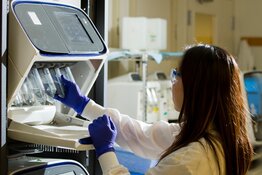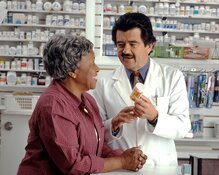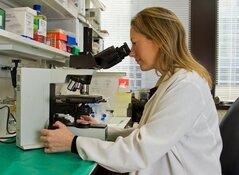The Life Sciences Report: Gil, Athersys Inc. (ATHX:NASDAQ) was incorporated in 1995, when cell therapies were a nascent idea and there were many safety concerns. These days, we're seeing safety across the industry, ignoring CAR T-cells and genetically modified cells. Have you now established that your cellular therapies are safe? Can you now begin looking for efficacy data as primary endpoints in clinical trials without having to tiptoe through safety concerns?
Gil Van Bokkelen: We have seen a very consistent safety profile with MultiStem, our proprietary cell therapy platform, and in recent studies we have been more focused on evaluating efficacy, while also continuing to assess safety because that's not something we would ever take for granted.
Phase 2 trials are exploratory by their very nature, and help us learn about proper dosing, timing and route of administration. These studies can also help us establish evidence of activity and provide initial validation of mechanisms of action, and help us assess other parameters like appropriate clinical endpoints for potential registrational studies.
"MultiStem saw consistent safety and strong evidence of clinical benefit provided patients were treated within 36 hours."
We have seen some very important and exciting evidence of clinical benefit in some of our recent studies, in particular our ischemic stroke trial. We saw consistent safety and strong evidence of clinical benefit provided we treated patients within 36 hours. In fact, more recent analysis of trial results shows a substantial increase in the proportion of patients that achieved good or excellent recovery in all three of the rating scales used to evaluate patients, which evaluate gross disability, cognitive and motor skill function, and the ability of patients to engage in activities of daily living. We, and the clinical experts that have evaluated the results, are pretty excited about that.
TLSR: Your principal technology platform at Athersys is allogeneic multipotent progenitor cells branded as MultiStem, which you are developing in neurological, cardiovascular, and immune and inflammatory disease indications. This question goes to cost of goods sold (COGS). How many doses can be expanded from a single donor, and how hearty will these cells remain over time? Does freezing weaken these cells in any way?
GVB: The cells we work with have very robust growth properties, which is in contrast to other cell types. Most cell types isolated from the body have a limited ability to be expanded before they begin to lose their potency or die off. That limits the number of doses that can be produced with material isolated from a single donor. However, we have shown that with our platform we can produce the equivalent of millions of clinical doses from material obtained from a single donor.
Furthermore, we have demonstrated that our cells have a long shelf life—we have validated we can store them for years in frozen form. In combination, these features give us a considerable advantage from a production and clinical scalability perspective. When done properly, freezing does not adversely impact the cells, and we've conducted a number of studies to evaluate that.
TLSR: Do these cells have a tropism for inflammation? Have you demonstrated that they will migrate to inflammatory sites in humans? How long can they linger, and how long can their paracrine activities be sustained before they are cleared from the system?
GVB: Using a range of preclinical models, we and our collaborators have observed that our cells home to sites of tissue damage, injury and inflammation, and to key organs like the spleen. Published data shows they influence the body's response following injury and in various disease models. Those effects tend to be durable, even if the cells don't permanently engraft.
"Our most recent stroke trial showed a 27.1% absolute increase in the number of patients who achieved good or excellent outcomes."
We also see clear evidence that similar things are happening in human patients. But it's important to recognize that we can't always do the same types of analysis in humans that we can do in animals. In preclinical models, we can harvest tissues and organs and examine them microscopically, which we obviously can't do in living human subjects. However, recent data from our stroke trial shows that we are reducing circulating inflammatory cells, and also seeing a strong impact on reducing multiple key inflammatory factors following a stroke, all of which are consistent with key elements of our therapeutic hypothesis.
TLSR: What is your lead indication currently?
GVB: Our program for treating ischemic stroke is our most important, and I would say this program clearly has the greatest potential both clinically and from a financial perspective. Stroke is one of the biggest areas of unmet need, and represents a huge market.
That being said, we have some other very exciting programs, including our ongoing trial in patients who have suffered damage from a heart attack, or myocardial infarction, as well as another program to treat patients suffering from severe acute respiratory distress. Each of these represents a major area of unmet medical need, and we believe each could also be a multibillion-dollar market opportunity.
TLSR: In mid-April of this year, you announced results of a 136-patient, double-blind, Phase 2 trial in ischemic stroke that explored the possibility of expanding what is known as the "golden three-hour window." Can you explain what happens in that window typically? What are your plans going forward?
GVB: Current standard of care for ischemic stroke patients is a drug called tPA (tissue plasminogen activator). It was originally developed by Genentech (now a unit of Roche Holding AG [RHHBY:OTCQX]) approximately 20 years ago. The main problem with tPA is that it has to be given to the patient within several hours after the stroke—within 3 to 4.5 hours, depending on regulatory restrictions in the country the patient is being treated in.
The reason for the tight time window is that there are risks associated with tPA treatment. Specifically, there is an elevated risk of cerebral hemorrhaging among patients treated with tPA, and data suggests that risk increases over time during the hours after the stroke. So, from a safety perspective, tPA should only be given after the patient has been definitively diagnosed as having an ischemic stroke (and never given to a patient with a hemorrhagic stroke). Surgical approaches using mechanical reperfusion also have to be conducted within a few hours of the stroke, and are restricted to certain types of strokes in easily accessed arteries.
Most patients who have a stroke don't get to the hospital in time to get diagnosed and treated with tPA—only about 10% or less. There is great need for new therapies that could extend the treatment window by a meaningful amount—out to a clinically practical time frame so that more patients could be treated. Published studies indicate that more than 90% of stroke patients get to the hospital within 24 hours, and we and our advisors estimate that 95% or more of stroke patients reach the hospital within 36 hours. Extending the tPA treatment window out to 36 hours could have a major impact on stroke care.
"We are evaluating new regulatory pathways that may offer up an opportunity for accelerated development."
Our trial results provide evidence that administration of MultiStem within 36 hours of a stroke could be a very effective and safe treatment, and could help patients recover faster and more completely than the current standard of care may achieve. Specifically, from our more recent analysis, we learned that when MultiStem was administered within 36 hours of the time of the stroke to patients that received either no other form of treatment or received either tPA or mechanical reperfusion, 44.4% achieved good or excellent recovery in all three clinical rating scales used to evaluate patients, in comparison to only 17.3% of patients who received a placebo. In other words, there was a 27.1% absolute increase in the number of patients that achieved a good or excellent outcome if they were treated with MultiStem within 36 hours. That is a huge increase, and is exactly what patients, clinicians and the healthcare system have been looking for.
We are now in the planning stages for the next phase of clinical development. We are particularly interested in clinical development in the U.S., the European Union and Japan, and are evaluating new regulatory pathways that may offer up an opportunity for accelerated development.
TLSR: Gil, you are now beginning a 90-patient, Phase 2 trial with AMI MultiStem in non-ST elevation acute myocardial infarction (NSTEMI). It's a double-blind study, but the cells in the experimental arm of the trial will be administered directly into the coronary artery with a micro-infusion catheter. Cardiac function will be evaluated 120 days out. Will there be an interim look at the 120-day data? When might we expect to see the initial results from the trial?
GVB: We aren't planning an interim assessment for this trial. We look forward to completing enrollment as quickly as we can, and then reporting the data sometime in the second half of next year.
TLSR: If you show efficacy in this Phase 2 trial in NSTEMI, I wonder if MultiStem cells could potentially become a normal part of coronary artery grafting surgery? Could these cells be injected into the myocardium near or parallel to transplanted vessels? Perhaps the anti-inflammatory effect could promote more rapid vascular engraftment and reduce time to myocardial perfusion. The thoracic surgeon is already working at these sites, and the intramuscular injections could take no more than another five minutes prior to closure. Do you have any thoughts on this?
GVB: It's certainly an interesting concept. Our published results from the Phase 1 trial showed good safety, and also provided important initial evidence of benefit for patients who had suffered significant damage and reduced heart function following a heart attack. We've done work in multiple acute and chronic ischemia models of heart and vascular disease, and we believe that the combined effects of reducing inflammatory-mediated damage through multiple mechanisms, promoting reparative pathways involving T regulatory cells and other cell populations, and promoting new blood vessel formation, are all relevant to promoting healing and recovery for these types of patients.
TLSR: You've got a backburner program with a small molecule 5HT2c (serotonin) agonist program for obesity that works with the same general mechanism as Arena Pharmaceuticals Inc.'s (ARNA:NASDAQ) Belviq (lorcaserin), which was approved by the FDA in June 2012. Why do you believe this could be superior to Belviq?
GVB: In the past couple of years, there have been several new drugs approved for the treatment of obesity, including Belviq. However, each of these new drugs exhibit limitations that have significantly limited their uptake, particularly with respect to dose-limiting side effects and tolerability issues.
We have demonstrated, in preclinical studies, the superiority of our compounds in comparative studies with other agents, and we remain convinced we can deliver a safer and more effective approach to treating obesity. We also think that certain compounds we have developed have relevance in other areas, like schizophrenia, and we continue to advance these programs in measured and cost-effective ways while we explore partnering opportunities across a range of programs. Sometimes being patient is hard, but we are convinced that we have something with a lot of potential.
TLSR: You have entered into a collaboration with Chugai Pharmaceuticals Co. Ltd. (4519:TYO) to develop MultiStem in Japan for the treatment of ischemic stroke. Could you comment on the collaboration? How do you think Japan's new regulatory approval policies on cell therapies might affect development and commercialization of MultiStem in that country and in Western nations?
GVB: As I mentioned in our earnings call, Chugai is actively evaluating the results from the trial, and we have maintained a productive dialogue with the company. Chugai essentially has the summer to finish its evaluation, and under the terms of our partnership, would then be required to make a payment of $7 million to us in order to proceed.
I believe the regenerative medicine regulatory framework in Japan is well thought out and represents a compelling opportunity. We have been actively exploring ways to utilize it. Furthermore, I think it’s having an impact on the regulatory environment internationally, and we see some encouraging trends and events in the U.S. and Europe. I believe all of these are designed to promote the accelerated development of safe and effective therapies for areas of substantial unmet medical need, which is our focus at Athersys.
TLSR: Gil, Athersys currently has a market cap of about $100M. If any one of your therapeutic interventions is successful, your current valuation would look extremely inviting. Will 2016 be the year when Athersys begins to mature into a Phase 3 company?
GVB: As your question suggests, I think we are substantially undervalued at the moment, especially when you consider the potential value of the indications we are pursuing. This is true even taking into account the historical probabilities of success for any of the programs we are pursuing given our current stage of development.
As we think about discrete phases of development, we think about trials that are suitable for registrational purposes, and that's a major focus of the company right now, particularly when there are emerging regulatory pathways we might be able to leverage that could help us develop products faster and more cost effectively.
TLSR: Thanks for your time.
Gil Van Bokkelen has served as Athersys Inc.'s chief executive officer and chairman since August 2000. Van Bokkelen cofounded Athersys in October 1995 and has served as CEO and director since then. Prior to May 2006, he served as Athersys' president. From 2010 through 2012 Van Bokkelen served as chairman of the Alliance for Regenerative Medicine, a Washington D.C.-based consortium of companies, patient advocacy groups, disease foundations and clinical and research institutions committed to the advancement of the field of regenerative medicine. He is also chairman of the Board of Governors for the National Center for Regenerative Medicine, and serves on a number of other boards, including the Biotechnology Industry Organization's board of directors (from 2001 to 2004, and from 2008 to present), the McGowan Institute for Regenerative Medicine and the Regenerative Medicine Foundation. He received a doctorate in genetics from the Stanford University School of Medicine, a bachelor's degree in economics from the University of California Berkeley, and a second bachelor's degree in molecular biology from UC Berkeley.
Read what other experts are saying about:
Want to read more Life Sciences Report interviews like this? Sign up for our free e-newsletter, and you'll learn when new articles have been published. To see recent interviews with industry analysts and commentators, visit our Streetwise Interviews page.
DISCLOSURE:
1) George S. Mack conducted this interview for Streetwise Reports LLC, publisher of The Gold Report, The Energy Report and The Life Sciences Report, and provides services to Streetwise Reports as an independent contractor. He owns, or his family owns, shares of the company mentioned in this interview: Yes.
2) The following companies mentioned in the interview are sponsors of Streetwise Reports: Athersys Inc.
3) Athersys Inc., represented by Gil Van Bokkelen, had final approval of the content and is wholly responsible for the validity of the statements. Opinions expressed are the opinions of Mr. Van Bokkelen and not of Streetwise Reports or its officers.
4) The interview does not constitute investment advice. Each reader is encouraged to consult with his or her individual financial professional and any action a reader takes as a result of information presented here is his or her own responsibility. By opening this page, each reader accepts and agrees to Streetwise Reports' terms of use and full legal The Life Sciences Report.
5) From time to time, Streetwise Reports LLC and its directors, officers, employees or members of their families, as well as persons interviewed for articles and interviews on the site, may have a long or short position in securities mentioned. Directors, officers, employees or members of their families are prohibited from making purchases and/or sales of those securities in the open market or otherwise during the up-to-four-week interval from the time of the interview until after it publishes.





































